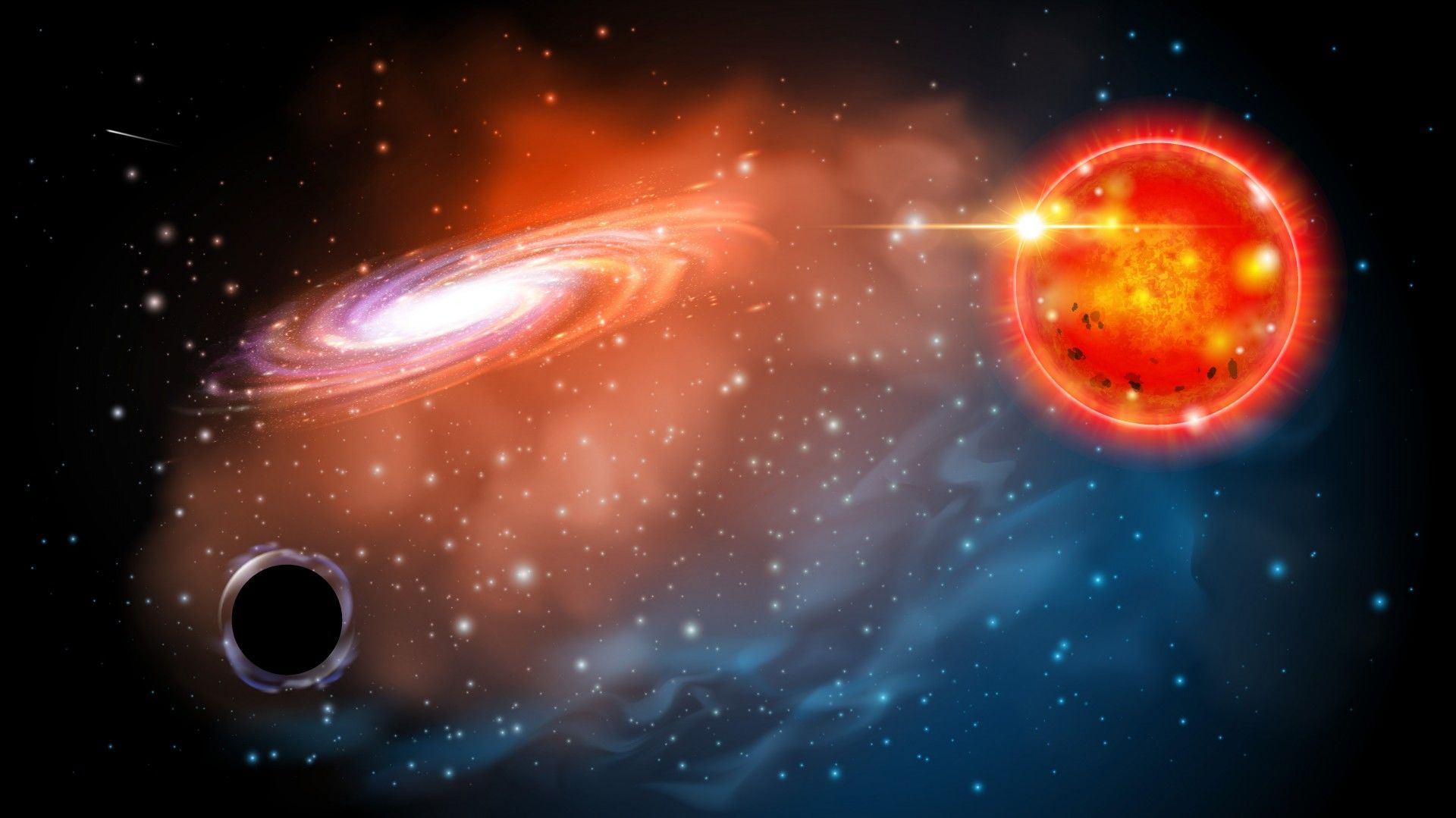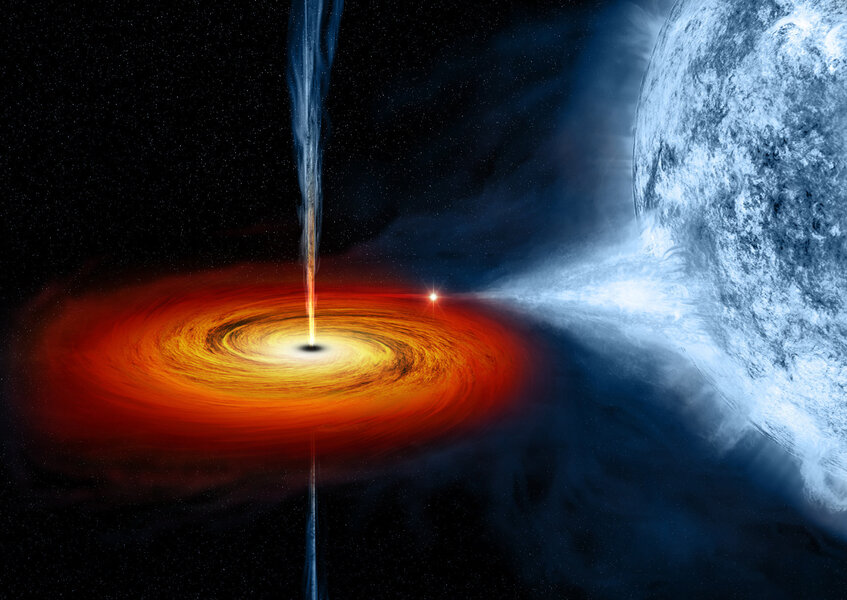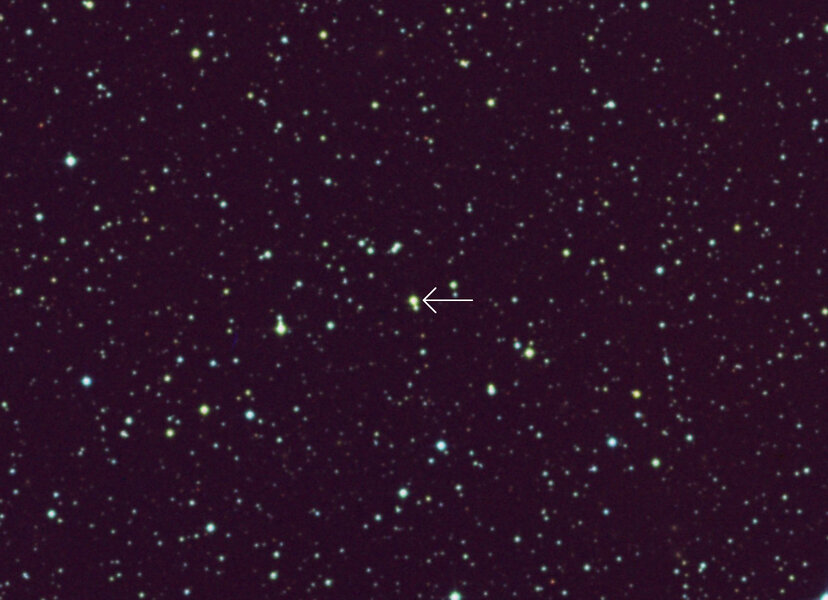Create a free profile to get unlimited access to exclusive videos, sweepstakes, and more!
The lowest mass black hole ever (not) seen may have been found

If you’re looking for irony, it doesn’t get much more ironic than black holes.
The densest objects in the Universe, their gravitational force is so fierce that anything that gets too close is gone. Over the event horizon and out of reach. Bloop. Down you go. Bye bye.
This makes them the darkest possible objects there can be. Not even light can escape them.
However, material that falls toward them may not fall straight in. It can spiral around and form a disk of matter. Stuff close to the black hole moves incredibly fast around it while stuff farther out is moving more slowly. That means there’s a lot of rubbing, a lot of friction. The material heats up. Matter that gets hot glows, and around some black holes there’s so much matter that’s so hot it glows incredibly brightly, bright enough to outshine entire galaxies!
That light is coming from just outside the black hole’s point of no return, so no laws of physics are being broken. But it does illuminate the irony: The darkest objects in the Universe power the brightest objects in the Universe.
And that’s a problem: The best way to see them is through the light of the material falling into them. The vast majority of black holes we’ve detected are due to this effect (and a few more thanks to them eating each other and sending out ripples in space-time called gravitational waves). We’ve found two classes of black holes this way: Supermassive ones at the centers of galaxies, with million or billions of times the Sun’s mass, and stellar-mass black holes, ones created when massive stars die. The outer layers of the star explode, while the core collapses to become a black hole. We’ve seen many examples of these: They’re spotted when they have a companion star, their fierce gravity ripping matter off the normal star and forming the bright disk around the black hole.
Theoretically speaking, the minimum mass for such a supernova-generated black hole is about three times the Sun’s mass. Realistically, though, we always see ones with higher mass than that, usually a dozen or more solar masses. That’s a little bit weird. OK, a lot weird. Where are all the ones closer to the lower limit?
Astronomers have just announced they may have found one. And there’s more irony to be had: It was found due to not seeing something there.
The star 2MASS J05215658+4359220 (yikes, let’s call it J0521 for short) is a hefty one, a lot more massive than the Sun. It’s a red giant, meaning it’s nearing the end of its life, and has expanded its outer layers hugely. Its mass and size are difficult to pin down, but it’s likely 3–4 times the mass of the Sun, and could be as much as 30 times the Sun’s diameter. Even though it’s cooler than the Sun (roughly 4,200°C versus 5,500° for the Sun) its large size makes it much more luminous, probably 150 times brighter than the Sun.
This is all quite normal for a star like this, but it’s doing something weird: It appears to be orbiting a massive object that can’t be seen.
In their paper announcing the results, the astronomers report they took spectra of the star, breaking its light up into hundreds of separate colors. A lot can be learned about the star this way, including its temperature, rotation, elemental composition… and its motion. They found it has an orbit of about 83 days around an object, and using various methods, this object appears to have a mass of 3.3 (±2.8/0.7) times the Sun. A star this massive would be very bright and obvious. However, no such star is seen there.
That leaves a dark, massive object. At that mass, the most likely explanation is a black hole.
If true, this is by far the lowest mass black hole ever found, close to the limit of how low mass one can be! That’s pretty cool.
I’ll note that a dark object with mass of 3.3 times the Sun doesn’t have to be a black hole. It could be, for example, be two old neutron stars orbiting each other. I talked with the lead author of the work, Todd Thompson about this, and he agreed it can’t be ruled out. But we also agreed it’s pretty unlikely. Neutron stars start off life as massive stars, and having a binary pair of massive stars orbited by a third star like J0521 is a bit of a stretch, especially since the massive stars would each become red supergiants before exploding, creating havoc in the system. There are also lots of age, mass, and separation constraints, all of which narrow down the window of possibility to a razor’s edge. In the end, the most likely explanation is the easiest one: a low mass black hole.
That is so cool.
Another thing. Over the weekend, on Twitter I happened to see a short thread by J. J. Eldridge, an astrophysicist who uses computer models and the latest physics to try to figure out how black holes form in binary systems like this:
The model can be run with lots of different inputs, like the initial masses of the stars, how far apart they are, and tons more. She talks about how she looked through his final models to see if any of them matched what was seen here, and she found one! It doesn’t mean this is exactly how the system formed, but I thought it was an interesting glimpse into how theoretical and observational astronomy mesh.
I’ll also note something else that’s interesting: Theoretically speaking, the lowest mass a black hole can have is roughly three times the Sun’s. But, that doesn’t mean we’ll ever find one like that! That’s a limit that comes out of the relatively simple physics of gravity, and not the messy reality of what actually happens inside the maelstrom of a star that’s exploding. IRL the black hole that forms has lots of sources for material as it forms and just after, so the actual lower limit for the mass of a black hole we’ll see is closer to five solar masses.
The fact that this one is so low mass is therefore fairly interesting. Theoreticians may have some trouble figuring out just why this black hole is so lean. They may simply have to load up a model with as many different configurations and as many different physics effects as they can, and run a bazillion scenarios to see which ones leave behind a wee black hole and a star like the system here. That’s basically what Eldridge did, but as she notes in that Twitter thread there is still some physics that could be added (notably a supernova kick, where the star explodes a little off-center, giving it a ferocious force to the side like a rocket engine; that can change the dynamics of the system considerably).
I’ll be very curious to see what comes out of this in the next few months. My biggest hope, honestly, is that more systems are found like this, because having just one makes it harder to understand. It could be a very special case, or it might be one of millions. The more examples you have, the better you can figure out what the heck is actually making these things.
… and they’re out there. There should be tens or hundreds of millions of stellar mass black holes in our galaxy alone, dark and invisible… unless we’re clever enough to figure out ways to spot them.

















